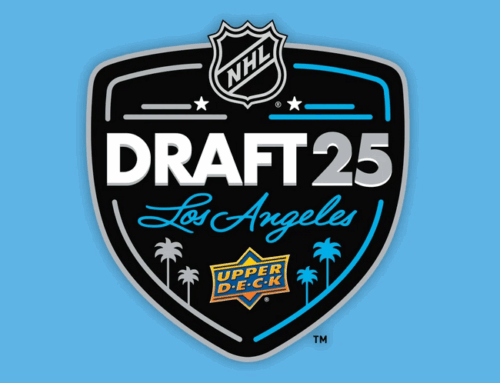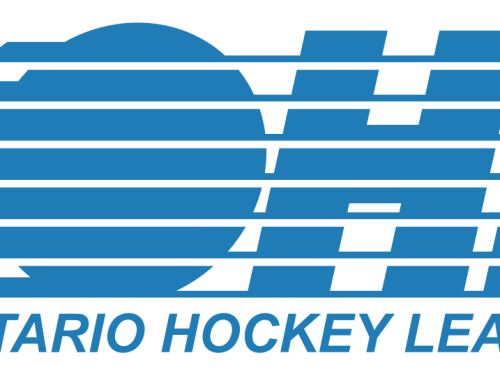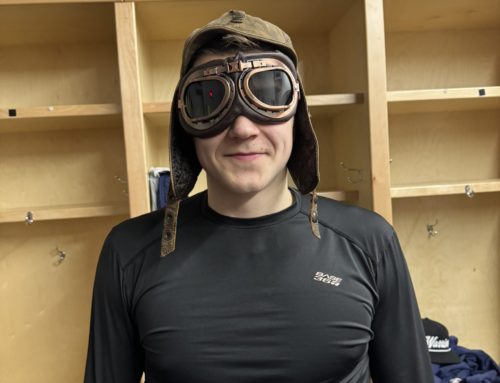Prospect Ramblings: Buying Low on Drysdale; K’Andre Miller’s Upside
Ben Gehrels
2022-12-14
Photo credit: Photo by Fred Kfoury III/Icon Sportswire via Getty Images
If you can afford to wait, now is an excellent time to send an offer on Jamie Drysdale (ANA) in keepers and dynasties. He has been out for a while now, and with races heating up a third of the way through the season, contenders may be looking to leverage dormant assets like him for win-now pieces. I have seen several trades like that recently involving Zach Werenski (CBJ), who put up a 58-point pace last year but won’t play again until 2023-24.
Injury aside, Drysdale is currently in that sargasso sea between draft day hype and breakout, meaning that devil on every poolie’s shoulder is starting to whisper, “What has he done for youuuuu lately?” He went pointless over his first eight games this year before landing on the IR, which is another red flag you can point to during negotiations.
According to Hockey Prospecting, Drysdale boasts the second highest star probability of the 2020 draft class (92%) after Tim Stutzle (OTT, 96%)—likely because he made the NHL in his Draft+1 year and did well at such a young age, potting 40 points over his first 105 NHL games. His trajectory reminds me of a less high-powered Rasmus Dahlin.
Drysdale’s career arc to date looks similar to Dahlin’s from their D-1 to their D+1 campaigns—though Dahlin was always a couple steps ahead—steady improvement and a high likelihood of becoming a star. Directly following the draft, Drysdale put up ten points in his first 14 AHL games and then graduated to the Ducks where he played almost 20 minutes a night for the rest of the year as an 18 year old. His production (eight points in 24 games) as an NHL rookie was nowhere close to Dahlin’s historic first-year campaign of 44 points but it is notable that both defenders took on significant NHL roles directly out of the draft.
There is also some context needed here. The Ducks finished second last in the league in that Covid-shortened 2021 season. The following year saw them move up into the bottom third of the pack, and Drysdale maintained his prominent role at both even strength and on the power play. He regularly faced other teams’ best players and still pushed his production into the mid-30s. This year, without Drysdale in the lineup, the Ducks are currently sitting dead last in the league. That is mostly just correlation but his absence is still a notable piece of the awful puzzle that is their season.
Remarkably, the Ducks’ farm team, the San Diego Gulls, are also currently dead last in the AHL. While there are bright spots like Benoit-Olivier Groulx (17 points in 24 games), former top prospects like Jacob Perreault (11 points) and Brayden Tracey (11 points) will need to step up their game in the minors for the parent club to see a meaningful boost in the near future.
With John Gibson and Lukas Dostal, the Ducks’ net will eventually solidify, and there are a number of skilled, long-term depth options on this team (Max Comtois, Ryan Strome, Frank Vatrano) that should allow Anaheim to move out of the league’s basement before much longer.
As it stands, one of the only bright spots to this mediocrity is that the Ducks should have a decent shot at winning the Connor Bedard sweepstakes this June. Even if that does not come to pass, they still stand an excellent chance of bringing a franchise-level talent on board either way. I doubt they re-sign struggling (and expensive) veteran John Klingberg, so a healthy Drysdale should be in line to reclaim his spot on the top PP alongside Trevor Zegras, Mason McTavish, Troy Terry, and one of Bedard, Adam Fantilli, or Leo Carlsson (if the Ducks go with Matvei Michkov he will be a multi-year wait).
As a final cherry on the cake to convince the Drysdale owner in your league to move on from him, point out the looming threat of skilled defenders Olen Zellweger and Pavel Mintyukov. Both have high-end offensive upside, are lighting up their junior leagues, and are ostensible threats to Drysdale’s PP1 role moving forward. No one can say what will happen a year or three from now but while Zellweger and Mintyukov (both 19 years old) certainly look impressive right now cruising along at well above a point-per-game pace in junior, they have a ton to learn and prove before they unseat Drysdale, who has already established himself as a valuable, NHL-quality defenceman.
While Mintyukov’s D+1 is still in progress, all three Ducks defenders share a D+1 NHL equivalency of 34 right now. In fact, all three look exceedingly similar in the model except for the fact that Drysdale jumped into the big leagues right after the draft. It might be exciting right now watching Mintyukov (39 points in 30 OHL games) and Zellweger (28 in 23 WHL) dominate against teenagers, but just remember that Drysdale put up 32 points playing 20 minutes a night in the NHL at the same age.
Recency bias is real in fantasy, and though Zellweger has taken a small step back this year offensively, his stocks should see a renewed boost when he dances the point for an absolutely loaded Team Canada at the upcoming World Juniors. With Drysdale stuck on IR and his future competition excelling on the world stage, this is the time to strike.
—
What to make of K’Andre Miller (NYR) in fantasy?
When I revisited the 2018 draft class for an article in November 2021, I wrote, “on paper, Miller looks similar to Noah Dobson: a big, smooth-skating defenceman with a safe floor and decent upside. Except that Miller might be more dynamic than Dobson.”
Obviously that Dobson take has not aged well. At the time, he had only four points in his first 15 games and 25 points over the first ~100 games of his career. He had some scoring success in junior but it was looking to me like he would become more of a defensive specialist. Of course, he picked things up right after that, scored at a 60-point pace the rest of the year, and is now one of the more exciting young defenders in the league.
Dobson aside, here is a goal Miller had just scored that month that inspired that “more dynamic” comment:
He is a 22-year-old, big-bodied defenceman who has the skill to pull off an incredible end-to-end rush like that and is effectively driving play in the top four of a contending team. If not more dynamic, could K’Andre Miller at least become as dynamic as Dobson?
The strange part is that Miller has a pretty firm reputation in fantasy circles as a defensive defenceman who does not have a lot of offensive upside. He flashed some scoring in his D+1 in the NCAA when he scored 22 points in 26 games for the U of Wisconsin. But then his totals regressed the following year, and he has never had a sustained scoring stretch in the NHL since then.
Until recently.
Miller had only three points in his first 18 games. Since mid-November, however, he has seven in 12. The sample size is still too small to make any firm conclusions, and there are a few red flags in his profile, but his recent performance is making me wonder what his offensive upside will ultimately be at the NHL level.
Here are a few of the red flags:
- Adam Fox gets nearly 80% of NYR’s PP time and that will not change.
- Without meaningful PP time, Miller’s point ceiling decreases by at least 10-15 points.
- Miller does not have a long history of prolific production at lower levels.
- He does not have the type of high shot volume you expect from offensive defenders.
- He primarily comes out for defensive zone draws and is used in a defensive role.
- At 6-5 and 215lbs, it will likely be 400 games until he hits his Breakout Threshold.
Miller does not profile like a star in the HP model but neither did Dobson. These red flags will keep his value down in fantasy for the moment but he will be a player to keep tabs on moving forward because of his role, potential, and athleticism.
Thanks for reading! Follow me on Twitter @beegare for more prospect content and fantasy hockey analysis.






